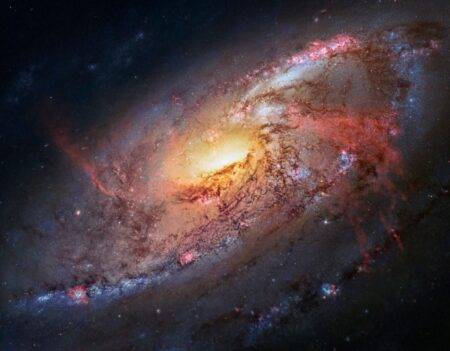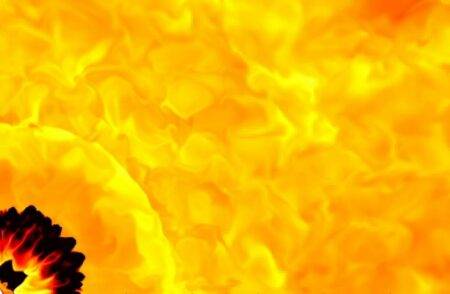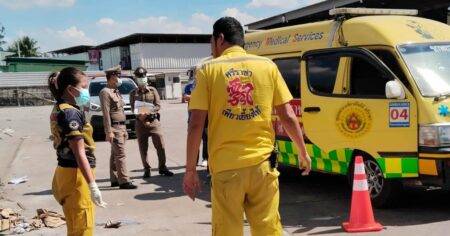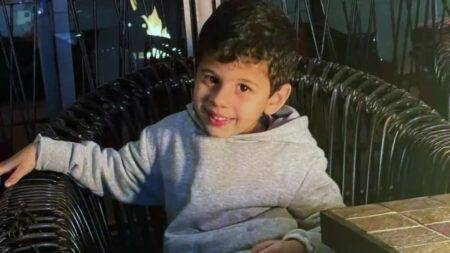She compared the room she was lashed in to a ‘medieval torture chamber’.
Browsing: World News
Latest World news news, comment and analysis from WTX News, the world’s independent and unbiased news publisher.
A Jeffrey Epstein victim claimed he filmed her friend having sex with Prince Andrew, ex-President Bill Clinton and magnate Richard Branson.
Dark energy makes up around 68% of the universe, but nobody knows what it is.
Condemning the ‘commercialisation’ of pregnancy, he said the life of an unborn child must not be ‘suppressed or turned into an object of trafficking’.
A plug door fell off one of the jets run by Alaska Airlines mid-flight last Friday.
Investigators are considering arson as a possible cause.
This computer simulation shows a galactic wind which blows gas out of the galaxy for 200 million years (Picture: SWNS)
Mysterious radio waves the size of several galaxies could be galactic winds from stars that exploded billions of years ago, according to new research.
The winds, which can travel at up to 2,000km per second, were only discovered in 2019 and have so far remained a mystery.
But a team of American astrophysicists now believe the waves are shells formed by galactic winds – possibly from massive exploding stars known as supernovae.
Computer simulations demonstrating galactic winds blowing over 750 million years offer an explanation for the radio circles which have left scientists perplexed up to this point.
Back in 2019, the newly-completed Australian Square Kilometer Array Pathfinder (ASKAP) telescope picked up something no one had ever seen before: radio wave circles so large they contained entire galaxies at their centres.
When they observed these radio rings, a team of researchers from the University of California San Diego studying ‘starburst’ galaxies believed they could provide the answers as to their origin.
Scientists had no idea what the bizarre radio signals were when they discovered them in 2019 (Picture: SWNS)
In their study, published in the journal Nature, the researchers delved into massive starburst galaxies that can drive these ultra-fast outflowing winds.
Starburst galaxies have an exceptionally high rate of star formation.
When stars die and explode, they expel gas from the star and its surroundings back into interstellar space.
If enough stars explode near each other at around the same time, the force of these explosions can push the gas out of the galaxy itself into outflowing winds – which can travel at up to 2,000 kilometres per second.
“These galaxies are really interesting,” explained astrophysicist Dr Alison Coil, a lead author of the study.
“They occur when two big galaxies collide. The merger pushes all the gas into a very small region, which causes an intense burst of star formation.
“Massive stars burn out quickly and when they die, they expel their gas as outflowing winds.”
Technological developments allowed ASKAP to scan large portions of the sky at very faint limits which made odd radio circles (ORCs) detectable for the first time in 2019.
These ORCs were enormous: hundreds of kiloparsecs across, where a kiloparsec is equal to 3,260 light-years.
For comparison, our galaxy, the Milky Way, is around a mere 30 kiloparsecs across.
Since the ORCs were detected, a multitude of theories has abounded to explain their origin, from planetary nebulae – an emission nebula consisting of an expanding, glowing shell of ionized gas ejected from red giant stars late in their lives – to black hole mergers.
But radio data alone could not discriminate between these various theories.
Dr Coil and her colleagues thought it possible the radio rings were a development from the later stages of the starburst galaxies they’d been studying, and began to look into ORC 4 – the first ORC discovered, which is observable from the Northern Hemisphere.
Until 2019, ORCs had previously only been observed through their radio emissions, without any optical data.
Dr Coil’s team, however, used an integral field spectrograph at the W.M. Keck Observatory in Maunakea, Hawaii, to look at ORC 4 which revealed a tremendous amount of highly luminous, heated, compressed gas – far more than is seen in the average galaxy.
Using optical and infrared imaging data, the researchers determined that the stars inside ORC 4 galaxy were around six billion years old.
“There was a burst of star formation in this galaxy, but it ended roughly a billion years ago,” Dr Coil said.
Dr Cassandra Lochhaas, a postdoctoral fellow at the Harvard & Smithsonian Center for Astrophysics and a co-author on the study, ran a series of computer simulations to replicate the size and properties of the large-scale radio ring, including the large amount of shocked, cool gas in the central galaxy.
Dr Lochhas’ simulations demonstrated outflowing galactic winds blowing for 200 million years before they shut off.
When the galactic wind stopped, a forward-moving shock continued to propel high-temperature gas out of the galaxy and created a radio ring, whilst a reverse shock sent cooler gas falling back onto the galaxy.
The simulation played out over 750 million years — within the ballpark of the estimated one-billion-year stellar age of ORC 4.
“To make this work you need a high-mass outflow rate, meaning it’s ejecting a lot of material very quickly,” Dr Coil said.
“And the surrounding gas just outside the galaxy has to be low density, otherwise the shock stalls. These are the two key factors.
“It turns out the galaxies we’ve been studying have these high-mass outflow rates. They’re rare, but they do exist.
“I really do think this points to ORCs originating from some kind of outflowing galactic winds.”
Dr Coil added that these outflowing winds could not only help astronomers understand ORCs, but could also help astronomers understand the outflowing winds themselves.
“ORCs provide a way for us to ‘see’ the winds through radio data and spectroscopy,” she said.
“This can help us determine how common these extreme outflowing galactic winds are and what the wind life cycle is.
“They can also help us learn more about galactic evolution: do all massive galaxies go through an ORC phase?
“Do spiral galaxies turn elliptical when they are no longer forming stars? I think there is a lot we can learn about ORCs and learn from ORCs.”
Your next break could be a little closer to home.
Biggest pop culture moments of 2023 2023 was rich in pop culture gold, from Gwyneth Paltrow’s court case to the Holly and Phil chaos, here…
2023 in review – Barbenheimer sweeps the world, Women’s World Cup breaks records, David Cameron returns & war in the Middle East The second half…
2024 will be world’s biggest election year ever -Who’s heading to the polls? Next year is going to be a busy year for politics,…
2023 celebrity deaths – a look back on who we lost this year As 2023 ends, the world is reflecting on another busy year. In…
The shipping container was delivered from the US.
Poland’s pro-EU government on Wednesday launched a reform of state media and sacked their management as right-wing lawmakers staged a sit-in to protest the changes and public broadcasts were interrupted.
The Russian soldier was unharmed, but the phone was completely destroyed.
Police discovered signs of a ‘violent struggle’, also discovered broken glasses and a broken speaker.
France’s Health Minister Aurelien Rousseau resigned as the government of President Emmanuel Macron on Wednesday sought to quell a party revolt over the passing of tough new immigration legislation backed by the far right. Following 18 months of wrangling over one of the flagship reforms of Macron’s second term, the French parliament passed the controversial legislation endorsed by Marine Le Pen’s National Rally (RN) Tuesday. Expected to address the reform in a television interview on Wednesday evening, Macron “will need to explain why he thinks this law was so important to pass,” FRANCE 24’s Clovis Casali said.
Gor Adamyan was shot dead by road rage driver in California 10 days before Christmas.
Human rights groups said Samira Sabzian was the victim of domestic violence.
‘Control and legislation can do more than mere repression.’
Rat-fever causes fever, vomiting and headache.
The 78-year-old was snatched from his villa on Saturday morning.
‘We were in disbelief when we figured it out. My dad and I just laughed and felt deflated at the same time.’
The new deal will significantly change how the bloc processes migrants.
Video footage showed high school students brutally beating a teenage boy near Marjory Stoneman Douglas High School (Picture: X)
Four high school students who were recorded slamming a teenage boy down into concrete have been arrested and charged in the brutal beating.
The cruel fight broke out last Tuesday near Marjory Stoneman Douglas High School, where one of the worst school shootings in US history occurred years ago.
A video shows a teen boy holding the victim on his shoulder and throwing him onto the concrete with his head hitting the ground first. The victim lies facedown with his blue shirt rolled half up his torso as a huge crowd watches around him.
‘Check if he’s breathing, dawg,’ someone is heard saying.
To view this video please enable JavaScript, and consider upgrading to a web
browser that
supports HTML5
video
Other teens turn the victim on his back and then to his side, as he appears unconscious.
Onlookers at North Community Park in Florida can be heard gasping in disbelief.
The teen boy suffered a cracked skull, WSVN reported. He was rushed to a nearby hospital.
Marjory Stoneman Douglas students Jordan Thompson, 16; Caleb Hensley, 17; and Sylvester Hicks Jr, 16, were arrested on Thursday. Coral Glades High School student Chinua Leefatt, 15, was also arrested. All four teens have been charged with felony battery and were taken to the Juvenile Assessment Center.
Marjory Stoneman Douglas High School student Caleb Hensley, 17 (Picture: WSVN)
Marjory Stoneman Douglas High School student Jordan Thompson, 16 (Picture: WSVN)
The charges reflect ‘the serious nature of their actions’, stated Coral Springs police.
Another suspect, Jahmeer Beautziel, 17, has not yet been arrested.
The victim suffered non-life-threatening injuries and is recovering at home. He has not been identified.
A friend of the victim, Patrick Fox, told the TV station: ‘I was there when they started chasing him, but when I left, he was just in an ambulance leaving, so I heard that he got… he fractured his skull or something.’
Marjory Stoneman Douglas High School student Sylvester Hicks, 16 (Picture: WSVN)
Coral Glades High School student Chinua Leefatt, 15 (Picture: WSVN)
An investigation into the incident continues.
‘The safety of our community and schools remains our top priority,’ police stated.
‘We want to assure the public that such behavior will not be tolerated.’
Marjory Stoneman Douglas High was the site of one of the deadliest school shootings in America on February 14, 2018. A 19-year-old former student, Nikolas Cruz, opened fire and killed 17 people. He was sentenced to life in prison in November 2022.
Get in touch with our news team by emailing us at webnews@metro.co.uk.
For more stories like this, check our news page.

























